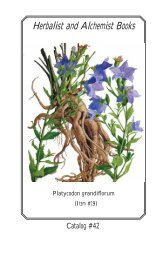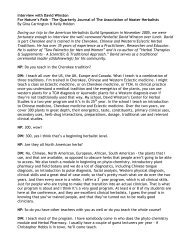MEDlCINAL PLANTS OF JAMAICA. PARTS 1 & 11.
MEDlCINAL PLANTS OF JAMAICA. PARTS 1 & 11.
MEDlCINAL PLANTS OF JAMAICA. PARTS 1 & 11.
You also want an ePaper? Increase the reach of your titles
YUMPU automatically turns print PDFs into web optimized ePapers that Google loves.
Wild varieties from Spain and Algiers contain about 4 percent essential oil with d-a-phellandrine as its principal<br />
constituent. (2, 3, 5, 15. 23, 27, 51, 61).<br />
VERBENACEAE<br />
PRIVA LAPPULACEA L. Clammy Bur: Bur Bush; Fasten.'pon-Coat; Rabbit Meat.<br />
This species continues in use as a cold bush. It is said to be used among the Mayas as a remedy for<br />
gonorrhoeea. Browne considered it "a fine vulnerary and sub-astringent" and said that it was used as a dressing<br />
for wounds and sores. (2, 5, 13, 15, 26, 50).<br />
STACHYTARPHETA JAMAICENSIS Vahl. Vervain: Porterweed.<br />
The use of vervain in the treatment of worms in children dates back to the early periods of Jamaican<br />
medicine and continues today. In the time of Barham, Lunan and other early writers it was considered useful as<br />
a purgative drink after the administration of worm remedies such as Asclepias or Mucuna or in some cases was<br />
itself referred to as vermifuge. Some use is still made of the sweetened juice alone or in combination with other<br />
worm remedies such as Annona muricata and Chenopodium. Its use as an emmenagogue is mentioned by<br />
Dancer and other authors. The old use of vervain in the treatment of diarrhoea is paralleled by its use in<br />
dysentery and diarrhoea cases among the Brazilian Indians. Sloane recommended its use with "spikenard" in the<br />
treatment of dropsies.<br />
West Indians of the Panama Canal Zone call the plant "porterweed" and employ it in domestic medicine.<br />
Tea made from it is said to foam like porter. In Brazil it appears to have been used to adulterate tea and to have<br />
been exported to Europe as "Brazilian tea". (1, 2, 5, 7, 11 13. 14, 15. 18, 19, 24, 27, 28, 37, 48, 50, 58, 60, 62).<br />
VITACEAE<br />
CISSUS SICYOIDES L. Pudding Wys (Withe).<br />
Commonly used as a general beverage with coconut milk or condensed milk. (2, 7, 8, 9, 11, 15, 16, 26,<br />
61).<br />
CISSUS TRIFOLIATA L. Sorrel Vine: Rat Ears; Pudding Wys?; Wild Yam?<br />
Only one informant has indicated uses for this vine: it was said to make tea for treating colds and the<br />
beaten leaves may be applied to sores and boils. Lunan claimed that all Cissus spp. made good poultices for<br />
ulcers and some species find a similar use in India and Africa. In Maya medicine this plant is crushed and used<br />
as a soothing poultice for headaches. (7, 11, 14, 15, 26, 56, 61).<br />
ALGAE<br />
GRACILARIA SP. Irish Moss.<br />
Irish Moss, sometimes the imported variet y (Chondrus crisp us) and sometimes a local alga sold by<br />
fishermen (Gracilaria sp.) is used in the preparation of tonics-see Pseudele. phantopus spicatus. Ceylon Moss<br />
which is also a species of Gracilaria has been official in the pharmacopoeias. Like Chondrus it has been used in<br />
pulmonary complaints. affections of the bladder and kidneys, dysentery and diarrhoea: it is considered nutritive,<br />
demulcent and emollient but it is not easily digested by invalids. Chondrus contains about 7% protein and 8-<br />
15% ash containing some iodine: it is also said to contain a gum-like substance called carrageenin which, on<br />
hydrolysis, yields fructose, galactose and sulphates. (3, 14, 23, 57).<br />
REFERENCES<br />
Parts 1 to IV<br />
1. Barham, H. (1794). Hortus Americanus. Kingston, Jamaica.<br />
2. Beckwith, M. W. (1927), Notes on Jamaican Ethnobotany. Vassar College Folklore Foundation. Pub. 8.<br />
New York.<br />
3. Bentley, R. and Trimen. H. (1880),. Medicinal Plants, I-IV. London.<br />
4. Britton, N. L. and Wilson, P. (1923-30). In Scientific Survey of Porto Rico and the Virgin Islands, 5 and 6,<br />
New York.







